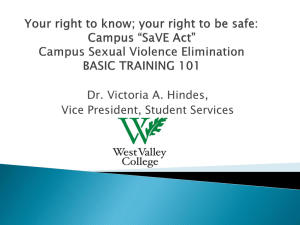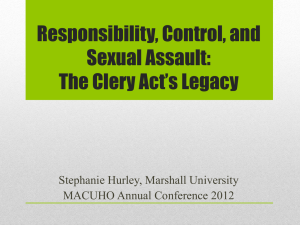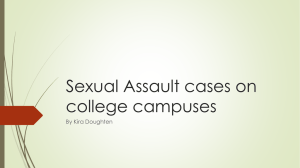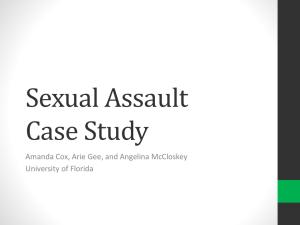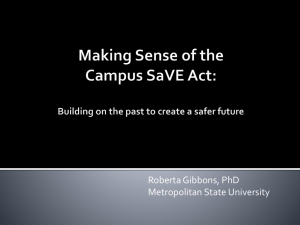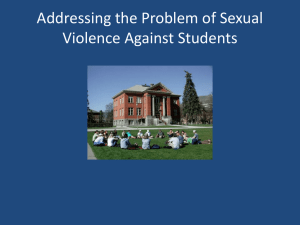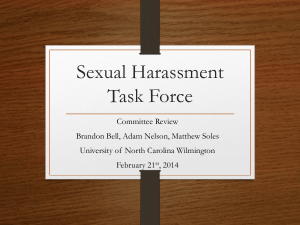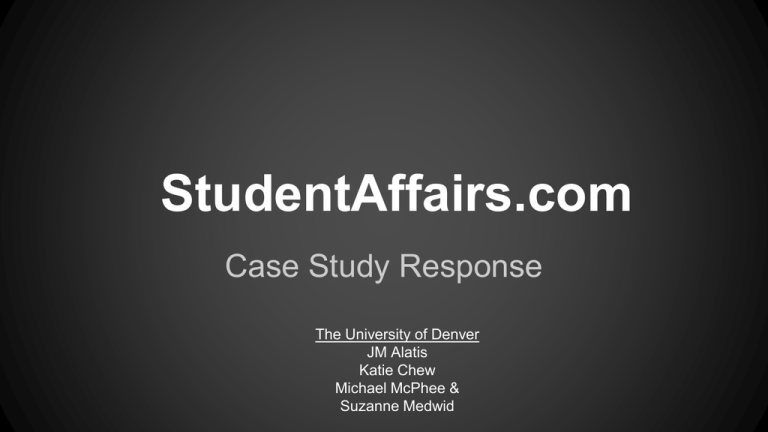
StudentAffairs.com
Case Study Response
The University of Denver
JM Alatis
Katie Chew
Michael McPhee &
Suzanne Medwid
Introduction
Case Study Reviewers will be able to…
Overview relevant sexual assault literature.
Understand the role of various national laws in Sexual
Assault Risk Reduction.
Understand current “Best Practices” in Sexual Assault
Risk Reduction.
Elaborate on Case Study Participant’s ideas for Risk
Reduction.
•
•
•
•
BACKGROUND INFORMATION
Relevant Literature
•
•
•
The ways in which people report sexaul assualt varies greatly. Overall
there are higher rates of informal reports versus formal. This impacts the
way that campuses offer resources to help those impacted and effected by
sexaul assault (Sabina & Ho, 2014).
Increased effectiveness of programs that are tailored to specific
populations in the community varying from gender to past experience with
sexual assault. This is important when determining the best methods to
understanding and educating about sexual assault on a campus (Macy,
Nurius, & Norris, 2007).
Importance of understanding the role of partner sexual violence. The role
of consent in these relationships and role of power dynamics at play. This
is important in ensuring all types of sexual assault are being addressed in
campus education (Logan, Walker, & Cole, 2013)
Jeanne Clery Disclosure of Campus Security
Policy and Campus Crime Statistics Act
•
•
•
Named after Jeanne Clery, a First Year student at
Lehigh University who was raped and murdered in her
residence hall.
Requires that colleges comply with federal mandates of
reporting campus crime activity.
University campuses must work on prevention of sexual
violence, as well as warning students of potential
threats to their wellbeing
(Clery Center, 2012)
Clery Act Regulations
There are four mandates within the Clery Act:
1. Publishing of an annual crime log by Campus Safety
2. A real-time, current updated listing of Campus Crimes
3. Data collecting and record keeping of campus crimes
for a minimum of 8 years.
4. Timely Warnings issued when the campus at-large is
still at risk
(Clery Center, 2012)
Violence Against Women Act
(VAWA)
•
•
•
•
Enacted by Congress in 1994
Strengthened federal penalties for repeat sex offenders
Created Rape Shield Law which prevents a victim’s
sexaul history against them during a rape trial
Established the National Domestic Violence hotline
(Factsheet: Violence Against Women)
VAWA Supporting Victims
• Ensures that victims do not have to bear the cost of their
•
•
•
rape exams
Protects women in Indian country by authorizing warrantless
arrest authority for federal law enforcement in domestic
violence cases where probable cause has been determined
Offers legal relief for battered immigrants so that their
immigration status is not used to prevent them from calling
the police
Supports tribal governments in protecting American Indian
and Alaska Native women
(Factsheet: Violence Against Women)
Sexual Violence Elimination (SaVE) Act
•
•
•
Updates Jeanne Clery Act
Addresses violence against women on campus
Requires campuses to report incidents of domestic
violence, dating violence, sexual assault and stalking in
an annual campus crime statistics report
(Clery Center, 2012)
Sexual Violence Elimination (SaVE) Act
•
•
•
Creates minimum standards for institutional disciplinary
procedures that cover domestic violence, dating
violence, sexual assault, and stalking
Encourages institutions to provide student and
employee programming that addresses domestic
violence, dating violence, sexual assault, and stalking
Establishes collaboration between the U.S.
Departments of Justice, Education, Health and Human
Services to determine best practices (Clery Center)
Office of Civil Rights Regulations (OCR)
•
•
•
On April 4, 2011 the OCR issued the Dear Colleague Letter
which explained that any federally funded education program
must abide by Title IX regulations (Office for Civil Rights).
The Dear Colleague letter also provides guidance on sexual
violence cases; outlines enforcement strategies;and explains
the role of Title IX, FERPA, and the Clery Act (Office for Civil
Rights).
The OCR also offers institutions assistance with preventing
and addressing discrimination (Office for Civil Rights)
(Office for Civil Rights, 2014)
Title IX
Higher Education Institutions are required to:
Respond promptly and effectively to Sexual Misconduct allegations
(for students and other affiliates).
Must respond to Sexual Violence claims, even if parents or
students object.
Criminal investigations do not replace institutional investigations.
Both must occur.
Each institution must distribute a policy on sex discrimination.
Each institution must have a Title IX coordinator
Each institution must make procedures for filing complaints known
to campus community.
•
•
•
•
•
•
(Department of Education, 2012)
Existing Best Practices
Best practices show that colleges have to educate and empower students through trainings, have community visibility and
provide the needed support and counseling to all individuals on campus.
•
●
●
Trainings:
o
Green Dot- “Ending violence one green dot at a time.” Green dot is a researched program to develop bystander
empowerment to end power based personal violence (Green Dot, 2010).
o
Bringing in the Bystander- Developed at the University of New Hampshire. The programs focuses on that everyone
has a role in stopping sexual and domestic violence (Know Your Power, 2011).
Community:
○
Know your Power Social Marketing Campaign- Implemented at the University of New Hampshire to enforce
Bringing the Bystander program. Posters were hung around campus highlighting different violence and assault
situation, and suggested ways to handle (Know Your Power, 2011).
○
Active student organizations who can create a community that prioritizes educating classmates around the statistics
of rape, abuse and violence on college campus.
Support:
○
Circle of 6 App- Winner of the White House/HSS App Against Abuse Technology Competition. Made for college
students. It fosters quick communication and location identification to 6 friends or family members (Circleof6, 2014).
○
CAPE Office- Confidential and non-reporting hotline and services for victims of sexual assault at the University of
Denver. Provides students with a 24 hour hotline to call to discuss concerns and inspire empowerment. (CAPE
2013)
○
Counseling support- Provide professional, regular and inexpensive counseling services to support students.
OUR PROPOSAL
Our Practices: An Overview
•
•
Developing 3 separate programs for various university
stakeholders, which will be required for some and
optional for others based upon their roles.
Stakeholders include: University Faculty, Staff and
Student Leaders; External Community Members
(restaurants, bars, and other establishments near the
campus); and Those Affected by Sexual Violence (both
survivors, bystanders, and alleged-aggressors).
Program 1: Bystander Intervention
Program Description
This 2 hour long training program is geared towards
student leaders, campus members, and local businesses
with the goal of establishing a network of individuals
dedicated to ensuring the safety of university students.
Due to the specific nature of each group, content can be tailored to
their specific needs.
Learning Goals
- Establish & Debunk Myths & Facts
- Elaborate on Prevention & Risk Reduction
- Inform Bystanders of their Responsibilities
Program 2: Title IX & Other Legal
Considerations
Program Description
This 2 hour long training program is geared towards
university employees (such as RAs, Graduate Assistants
in Student Life, and Professors) and other relevant
individuals (such as student members of conduct hearing
boards) who may deal with legal ramifications of sexual
violence.
Learning Goals
- Establish & Debunk Myths & Facts
- Overview of Title IX, Clery, VAWA, SAvE, and Office of
Civil Rights
- Relevance to the Honor Code & University Mission
- Accommodating Needs of Survivors
- Ensuring the Rights of the Accused
- Defining Consent
- Avoiding Victim Blaming
Program 3: Empowerment
This two hour long program will provide individuals in the
community resources to help stem the effects of sexual
violence. Particular attention will be given to both direct
and indirect survivors of sexual violence.
Learning Goals
- Establish & Debunk Myths & Facts
- Prevention and Risk Reduction
- Defining Consent
- Relevance to the Honor Code & University Mission
- Accommodating Needs of Survivors
Philosophical Considerations and
Program Implementation
Establish & Debunk Myths & Facts
•
•
•
•
Rape myth belief is tied to gender and “just world belief” (Hayes,
Lorenz, & Bell, 2013).
Rape myth belief may be why low rates of reported sexual assault
exist (Hayes, Lorenz, & Bell, 2013)
In bystander training we will have a section of curriculum that
covers the myths of sexual assault
For various scenarios and tactics given to participants processing
questions will be centered around sexual assault myths.
o Through this processing participants will be able to apply newly
learned facts to real life scenarios to see how attitudes can shift
when facts surrounding sexual assault impact decision making.
Establish & Debunk Myths & Facts
•
•
For Title IX and Other legal considerations training, the institution
will examine current policies that perpetuate myths of sexual
assault.
o Staff will have a two hour long training where these new policy
changes are discussed and implications for practice.
During the empowerment week a panel of survivors, experts, and
supporters would be used to share their perspective and story.
o In this panel format participants will be able to ask questions
and the moderator can ask questions to debunk myths and
perspectives.
Role of the Bystander
•
•
Research indicates that 80% of college men feel
uncomfortable when they see a woman being
mistreated (Bystander Intervention). Often times they do
not intervene in a situation because they feel that they
are the only person who feels uncomfortable.
During this training individuals will participate in role
play scenarios that will allow them to gain the skills and
confidence necessary to step in during an actual
situation.
Overview of Title IX, Clery, VAWA,
SAvE, and Office for Civil Rights
Using the information in this PowerPoint, we will present
an overview of each law. We will highlight the specific
responsibilities of the group (student, faculty, staff or
community member) we are presenting to. We will invite
individuals from the campus (Campus Safety, Health and
Counseling and Office of Civil Rights) to speak on their
expertise.
Ensuring the Rights of the Accused
•
•
The accuser has the right to a confidential Title IX
investigation and to provide evidence (how to report,
2013).
We will use real journal and newspaper articles about
Title IX investigations to understand the rights and
processes for the accused.
Defining Consent
•
•
•
It is important that we establish a culture that recognizes gaining
consent , defined as a voluntary agreement between two
individuals who are engaging in sexual activity, as a necessary
action.
It is also important to note that people under the influence of drugs
or alcohol are not capable of giving consent.
Participants in all three programs will be given scenarios and will
be asked to determine whether or not consent has been given by
both parties involved. A debrief session at the end of each program
will allow facilitators to ask questions that allow participants to
reflect on how the activity relates to bystander intervention, legal
considerations, or empowerment.
Avoiding Victim Blaming
It will be relevant to teach advocates ways to avoid victim blaming. By
asking them what they think “causes” rape, we will debunk the
thoughts victims are responsible for their attack, by explaining:
Survivors should be reaffirmed that nothing they did “caused” them
to be victimized.
One should not be blamed for being a “victim”, rather blame should
be placed on the aggressor.
Actions should be attributed to the aggressor, rather than the
actions of the survivor.
How someone dresses, how much they drink, or how much they
flirt are not reasons for assault.
•
•
•
•
(Factsheet, 2014)
Prevention and Risk Reduction
Through group discussion, we will elaborate on ways that everyone
can reduce risk and talk about “preventing” rape:
We must be careful to say that we can “prevent” rape or sexual
violence. Rather, we can reduce risk.
During this presentation, we will address ways that one can reduce
risks -- including, but not limited to, alcohol safety, current best
practices (like the aforementioned Circle of 6 App), etc.
This will also focus on reducing “victim blaming” and explaining that
Sexual Violence survivors can be men, women, LGBT, or straight.
•
•
•
(Colorado State, 2014)
Relevance to Honor Code &
University Mission
•
•
•
It is important when talking about empowerment to understand how the
university’s mission and honor code apply to the community understanding
of sexual assault.
University mission and honor code will be used in teaching during
bystander intervention training and the two hour long Title IX and Other
Legal Consideration as a foundation for understanding the training.
Relevant statements from the mission and honor code would be printed on
commitment banners where students can sign them indicating their
support of the statements and commitment to not violating them.
Final Considerations
Importance of Social Media
•
•
•
It is exceptionally important to establish that social
media can be used to either aid or hinder the discussion
of sexual violence.
For instance, the role social media played in the
Steubenville Football rape case was both harmful and
triggering, yet shed a light on the situation. (Huffington
Post, 2013)
Social Media can be an ally--such as the use of the
Circle of 6 App and GreenDot (2014)
References
CAPE (2013). Retrieved February 16, 2014 from http://www.du.edu/health-and-counseling-center/cape/index.html
Circle of 6 (2014). Retrieved February 16, 2014 from http://www.circleof6app.com/
Clery Center (2012). Campus Sexual Violence Elimination Act. Retrieved February 15, 2014 from http://clerycenter.org/campus-sexual-violence-eliminationsave-act
Factsheet: Violence Against Women. Retrieved February 15, 2014 from http://www.whitehouse.gov/sites/default/files/docs/vawa_factsheet.pdf
Green Dot (2010). Retrieved February 16, 2014 from http://livethegreendot.com/
Hayes, R.M., Lorenz, K., & Bell, K.A. (2013). Victim blaming others: Rape myth acceptance and the just world belief. Feminist Criminology 8(3) 202-220.
How to Report (2013). Retrieved February 16, 2014 from http://www.du.edu/health-and-counseling-center/cape/report.html
Jeanne Clery Act Text as Amended Through 2008. (2007). In Clery Center for Security on Campus. Retrieved February 18, 2014, from
http://clerycenter.org/sites/default/files/Jeanne%20Clery%20Act%20Full%20Text.pdf
Know Your Power (2011). Retrieved February 16, 2014 from http://know-your-power.org/
Logan, T.K., Walker, R., & Cole, J. (2013). Silenced Suffering: The Need for a Better Understanding of Partner Sexual Violence. Trauma Violence Abuse.
DOI:10.1177/1524838013517560
References Continued
Macy, R.J., Runius, P.S., & Norris, J. (2007). Latent profiles among sexual assault survivors: Understanding survivors and their assault experiences. Journal of
Interpersonal Violence, 22(5), 520-542. doi:10.1177/088626050629883
Men Can Stop Rape (2011). Bystander Intervention. Retrieved February 10, 2014 from http://www.mencanstoprape.org/Theories-that-Shape-OurWork/bystander-intervention.html
Office for Civil Rights (2011). In U.S. Department of Education. Retrieved February 20, 2014 from http://www2.ed.gov/about/offices/list/ocr/docs/dcl-factsheet201104.html
Pelosi, C. (2013, November 23). Steubenville Rape Case: Enablers Have Consequences. The Huffington Post. Retrieved February 18, 2014, from
http://www.huffingtonpost.com/christine-pelosi/steubenville-rape-scandal_b_4338406.html?utm_hp_ref=steubenville-rape.
Primary Prevention vs. Risk Reduction (2014). In Colorado State University . Retrieved February 19, 2014, from http://wgac.colostate.edu/primaryprevention-vs-risk-reduction
Sabina, C., & Ho, L.Y. (2014). Campus and College Victim Responses to Sexual Assault and Dating Violence, Disclosure, Service Utilization, and Service
Provision. Trauma Violence Abuse. DOI: 10.1177/1524838014521322
Title IX (2011). In US Department of Education. Retrieved February 18, 2014, from https://www2.ed.gov/about/offices/list/ocr/docs/title-ix-rights-201104.pdf

